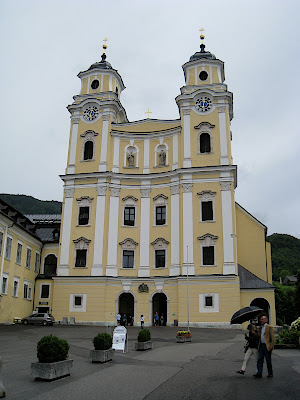
About a century ago, a beer cellar was excavated in the rock under the
Schloßkirche (Castle Church) in Haigerloch, a small town 70 km away from Stuttgart. During the final days of the Second World War, German physicists, under the direction of
Werner Heisenberg, were trying to create a sustained nuclear chain reaction with uranium in this cellar. The German physicists who participated in the research denied that they were trying to build an atomic weapon, although the Allied thought otherwise and sent the
ALSOS mission to look for the nuclear research facilities and scientists.
This site selection was peculiar, but understandable. The cellar was hidden from Allied's aerial bombing, and was sufficiently far away from Soviet advancement (the German scientists thought it was essential that their work would not fall into the hands of the Soviet). The ALSOS mission dismantled the laboratory upon their arrival in early 1945. They almost blew up the whole cellar, but was later persuaded not to do so as it could also do irreparable damage to the
Schloßkirche above and the civic morale.


At the end, the ALSOS mission removed most of the materials in the lab, and the aluminum containment vessel that lined an excavation in the ground in the cellar was destroyed. This
vessel is now on display at one corner of the cellar, which was turned into the
Atomkeller-Museum (Atomic Cellar Museum) in the 1980s. There is also a model of the proto-reactor with hanging uranium cubes. Here you see Gabriel standing in front of this model.

One of the physicists in the project, Karl Wirtz, led the construction of the first research reactor (
Forschungsreaktor 2, FR2) in Germany, which did not come into operation until early 1960s. This FR2 reactor was built at
Kernforschungszentrum Karlsruhe (Nuclear Research Center Karlsruhe), whose research program has now diversified beyond reactor research and is now known as
Forschungszentrum Karlsruhe (FZK, the host laboratory of my sabbatical). Coincidentally, there are replicas of
Otto Hahn's laboratory bench at Haigerloch's Atomkeller-Museum and at the display area of FR2 at FZK. Since this work bench of the co-discoverer of nuclear fission is of historical significance, the original is kept at the
Deutsche Museum in Munich.
Unlike the
Manhattan Project, the German's nuclear research during the war never turned into a huge industrial complex. Hence, the operation at Haigerloch was miniscule compared to that at Los Alamos at the time. There is a commonality beyond fission research between the two sites, however. The sceneries in their respective surrounding areas are gorgeous (in a different way, of course). Here is the view of the
Schloßkirche from a higher viewpoint across the town.

More pictures from Haigerloch can be found
here.
























































